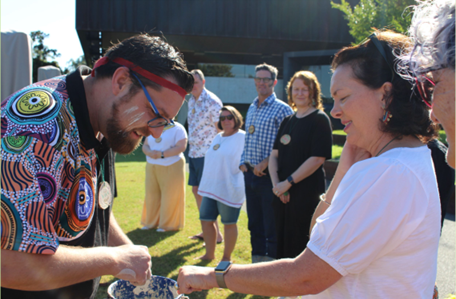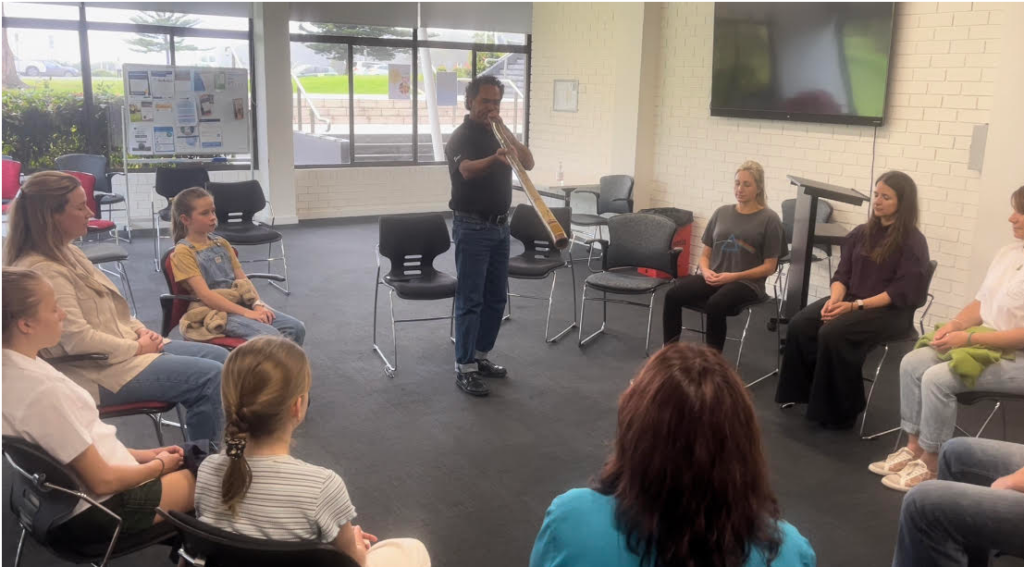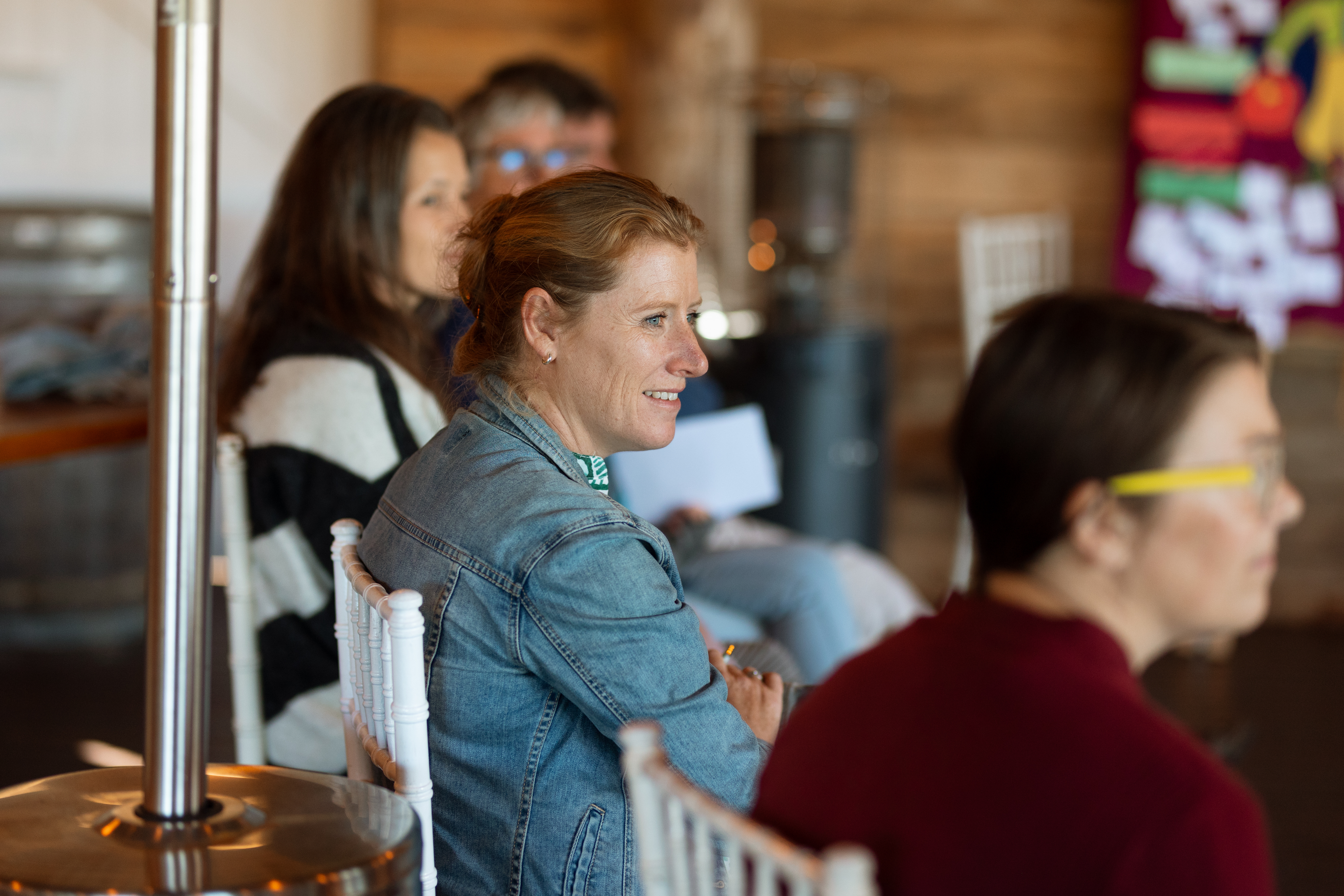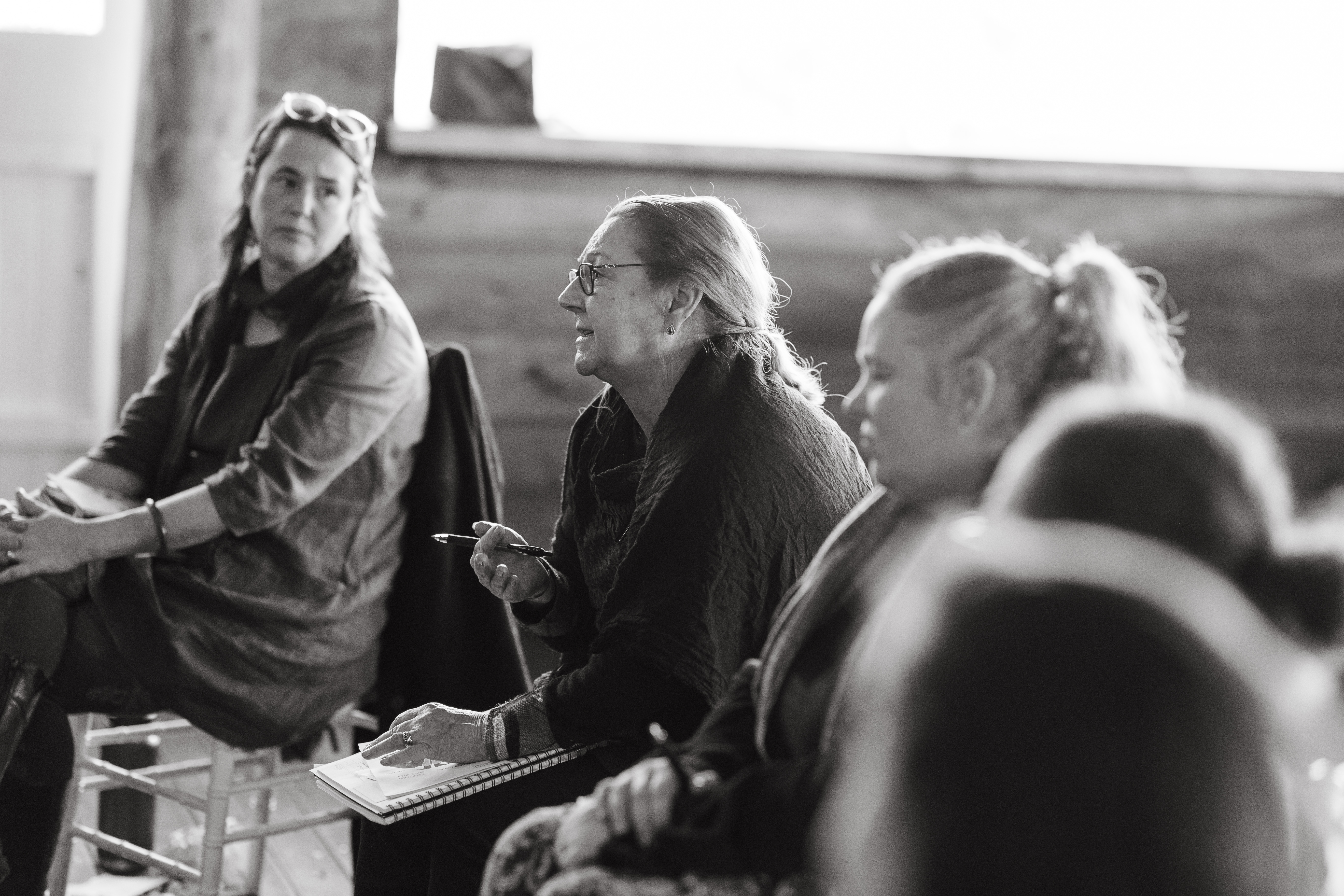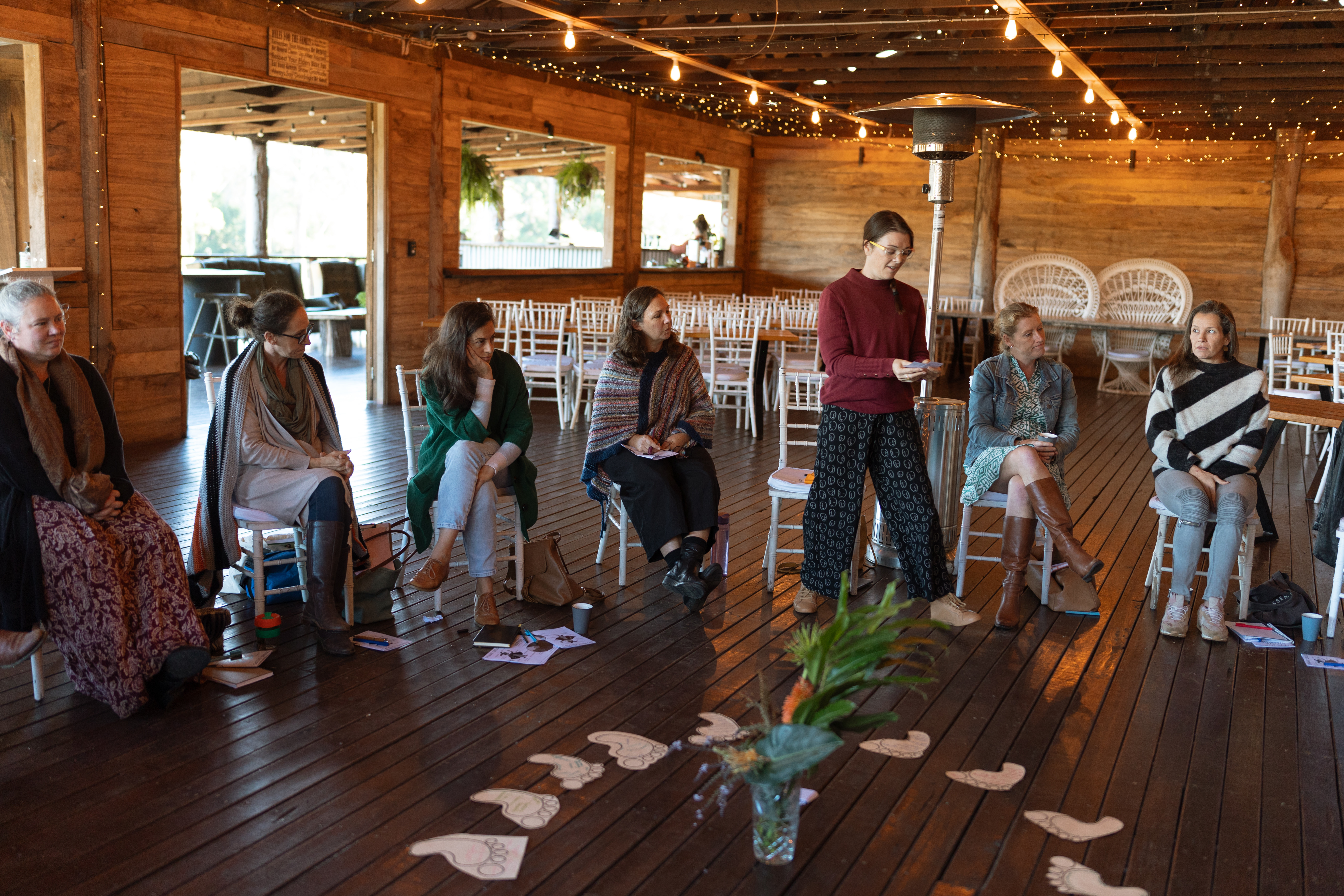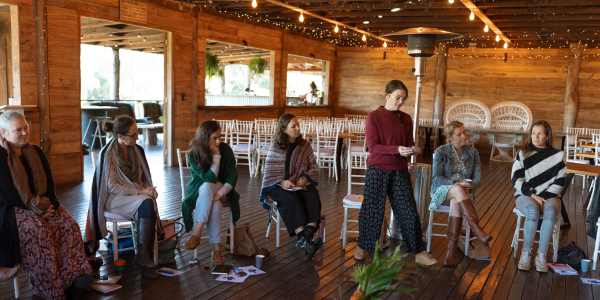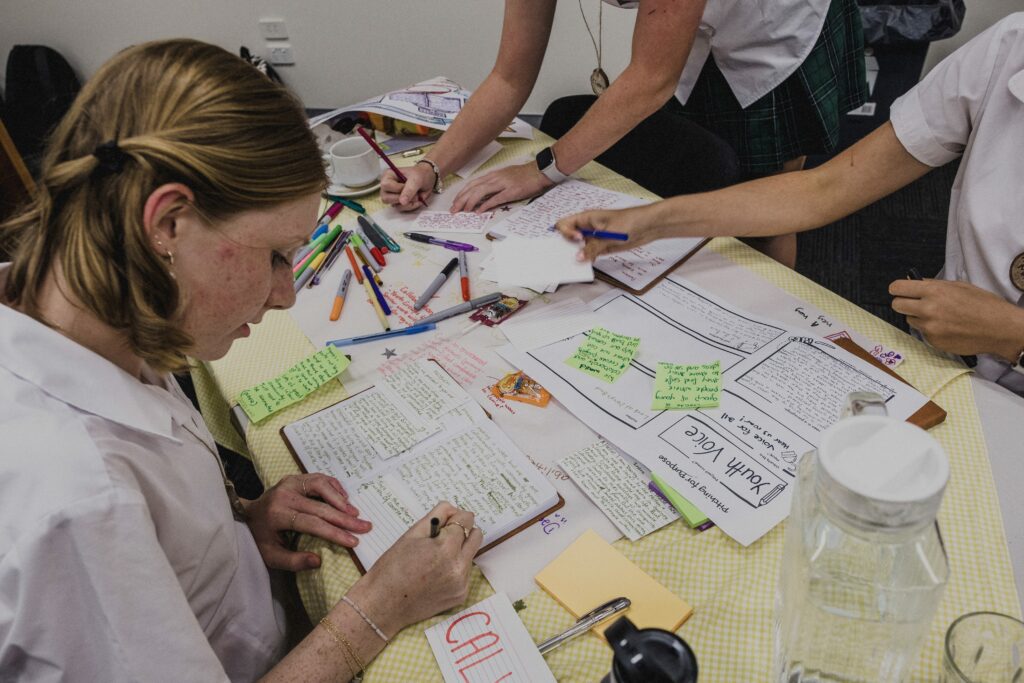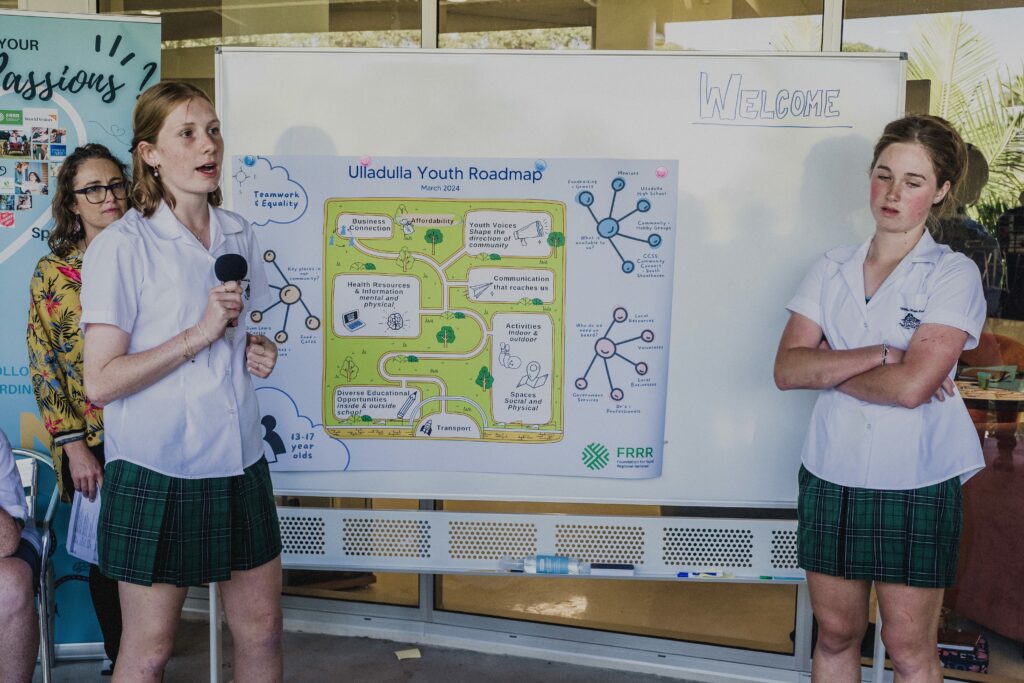Foundation for Rural & Regional Renewal (FRRR)
This article is a personal reflection from our IRCF Program Facilitator in Ulladulla, Monique.
Over the past five years, the IRCF program has woven a rich tapestry of community growth and cultural understanding through an array of touchpoints, workshops, group discussions, events and training sessions. These have allowed community members to network and learn a little bit more about our local Indigenous culture.
As the Ulladulla Community Facilitator, I’ve had the privilege of participating in numerous Welcome to Country ceremonies, each one deepening my appreciation for our connection to this beautiful land and its traditional custodians. I have also enjoyed hearing many community members personalising their Acknowledgements of Country and learning about their connection to this beautiful Yuin nation.
Some of my memorable experiences with community members include:
- Participating in my first smoking ceremony to officially open the High School Sanctuary;
- Witnessing artist Nicole Smede sing in the Dhurga language where her beautiful voice resonated with the spirit of our culture, reminding us of the importance of preserving endangered languages as well as endangered species;
- Didgeridoo meditation with Matt King;
- Standing barefoot, with my hand being painted in ochre;
- Listening to Elders speak about the endangered Black Cockatoo;
- The moving sounds of clapsticks; and
- The graceful dances and storytelling that provided deep insights into Indigenous traditions.
I have also enjoyed sitting in circle with the Ulladulla Yarning Mob to explore how we can help them connect to cultural practices, as well as discussing with local groups how they can learn more about culture and support our local Indigenous service providers.
Throughout our road mapping, workshops, and discussions, we embraced the ancient practice of ‘Sitting in Circle.’ This method, rooted in Indigenous cultural ways, ensures everyone has an equal seat at the table, fostering safe spaces for discussion and allowing for the sharing of passions and perspectives. One local resident, Webby from Lake Conjola, commented that this inclusive hosting method made him feel ‘safe and heard’ and encouraged him to explore various community activities.
Sitting in Circle has also empowered our community to bravely tackle important and difficult conversations. We’ve explored collective needs over individual priorities. Exploring ways to support local Indigenous and other minority groups through our community vision and principles, conversations, offers of support and actions.
I am grateful for the opportunities the IRCF program has provided, allowing myself and many community members to continue our lifelong journey of learning about Indigenous culture. My heartfelt thanks go to the local Indigenous community members who have generously answered our questions, supported and inspired our learning.
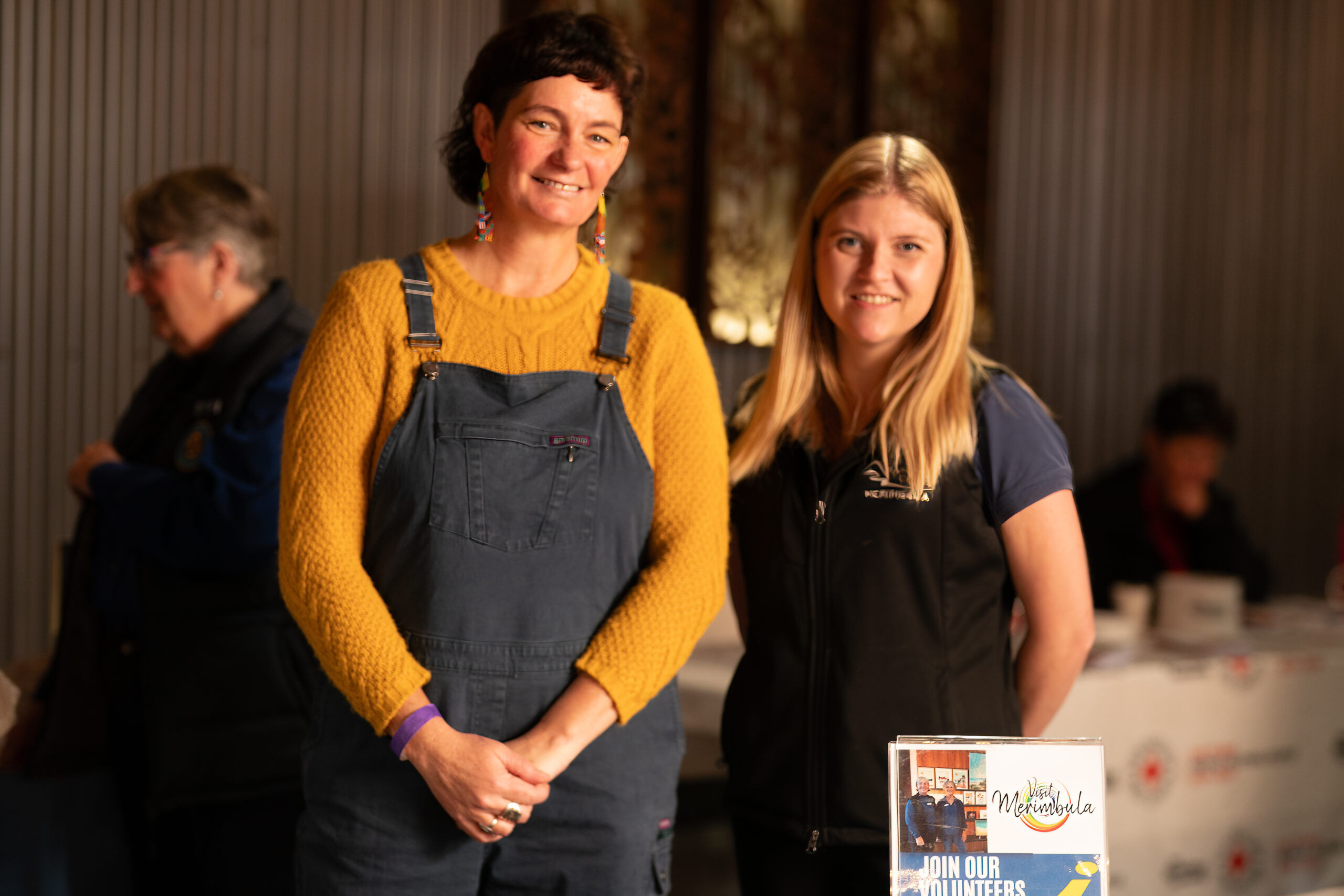
Following Black Summer, the Women’s Resource Centre (WRC) identified the need for more volunteers around women’s issues in Bega Valley. So, they decided to create a role for a Volunteer Program and Activities Coordination Project Worker.
Among the responsibilities of the role were:
- Revising induction processes and forms;
- Maintaining regular communication with volunteers;
- Ongoing support and supervision of volunteers;
- Developing rosters;
- Designing recruitment and workshop flyers;
- Liaising with workshop facilitators; and
- Liaising with other community organisations about volunteer opportunities.
Jade Simpson was recruited into the paid role, working 21 hours a week, supported through FRRR’s IRCF program. Bringing a wealth of insight on the local community and exceptional interpersonal skills to the role, Jade’s been highly successful in recruiting and retaining volunteers at the WRC. During the project, 21 women volunteered more than 350 hours of time at the Centre, taking on roles such as meet and greet, gardening, organising and tidying the Centre, providing admin support and contributing to the Southern Women’s Group historical research project. Jade has also been instrumental in the facilitation of more than 17 workshops. Several volunteers have now become regular weekly contributors, while others have since transitioned to work opportunities.
Jade says that a key element of success has been training, both for herself and WRC Manager Jane Hughes, in addition to the volunteers. Topics included grant writing; suicide prevention; digital mentoring; volunteer recruitment and retention; and domestic violence awareness.
According to Jade, the key to success however was having a clear plan for engagement and sharing the outcomes from the increased volunteering. This included speaking with local media to promote volunteering and at events such as Mental Health Week, the National volunteer Week Celebration, the ‘Many Hands’ Volunteer Expo and to Bega Valley Shire Council.
Having this role allowed Jane to focus on efficiently running the busy Centre in her own limited work hours and to be more readily available to the women accessing the service. The impact of the role has been so significant that WRC has been successful in obtaining further funding to maintain the role for a greater length of time.
“Jade has been incredible, the project has significantly increased volunteer engagement at the WRC. Her hard work has made it possible for us to provide essential training opportunities, to facilitate stronger community engagement and crucially, to work towards securing the continuity of the volunteer coordinator role through various grant applications,” Jane told us.
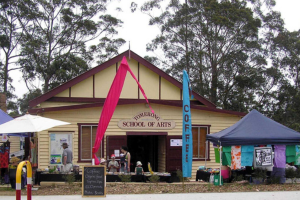
There are often significant and unexpected benefits when NFPs are given support to build their networks and develop strong and effective systems.
A case in point is the Tomerong School of Arts (TSA) in NSW. It manages the Tomerong Hall, which has been a community owned and managed facility since 1926. But they noticed lingering impacts from COVID, including social isolation. When the area lost access to local media outlets, and with internet access in the area poor, it was difficult to let locals to know about opportunities to come together.
Through the IRCF program, TSA sought funding to enhance communication within the community. They opted for a two-part plan designed to strengthen community networks, develop partnerships between NFPs and businesses, and generally foster social capital.
The first project was to create a Welcome Guide for people new to the area, containing information about other NFP’s in the area, available resources, activities at the Hall and the monthly markets. The second was the development and distribution of four newsletters, called the “Tomerong Trumpet”.
The publications were all developed locally, with input from an editor and local artists and published by a local printer. A variety of contributions were also made by local services, people and NFPs. Editorials in the newsletter included information on community fundraising activities and social events, community services and newly established businesses such as Dave’s Coffee Van, based at Tomerong Hall.
With people not having individual mailboxes in the area, distribution was facilitated by several businesses and community services, including Tomerong Post Office, the Tomerong markets and the School of Arts themselves. Digital copies were also made available through social media.
This new way of communicating yielded multiple benefits, including an opportunity for community members to learn journalism, website development and communication skills. In fact, the quality of the Welcome Guide and newsletters was so high that the Editor was approached by various local businesses for advertising. The resulting revenue was used to print beautiful, glossy covers for the publications.
The impact of this project cannot be understated. There has been a 56% increase in the number of stall holders at the Tomerong markets and a 48% increase in market attendees. There has also been an increase in the quantity and diversity of activities at Tomerong School of Arts, with the hall being hired for Yoga, Tai Chi, NDIS groups, weddings, memorials, events during Harmony Week, by the LGBTGIA+ community and various dance groups.
The Hall has become a hub of activity and a source of wellbeing and information for everyone in the community and they were even required to expand their management committee with two additional members.
Perhaps most important of all though, the communication activities have had wonderful ripple effects, including introducing local residents to each other & consolidating a wonderful sense of community. A great example of how this organisation delivered on their goals to better connect with people in their local area and help them become more responsive to community needs and aspirations.
Through IRCF, we saw that organisations that had capability in forming and nurturing partnerships and could engage with multiple community perspectives experienced a greater impact from being involved in the program. This reinforces that strong collaboration is built from experience, different skills and approaches. This was explored recently in more depth at a workshop in the Nambucca Valley.
Bowraville Social Enterprise Precinct (BISEP) has held a series of activities to equip themselves with resources to support the Nambucca Valley community moving forward. Recently, Robin Clayfield shared her expertise in supporting organisations and grassroots community groups to work together effectively for positive change at a session called Dynamic Groups and Sociocracy.
The workshop offered interactive ways for groups to develop a strong sense of culture and clear strategy that is inclusive of multiple perspectives. Robin ensured the group was aware of the facilitation techniques she was using so that they had the ability to use the new skills immediately. She also offered the group an introduction into Sociocracy and the opportunity to practice the process, an interesting methodology that enables diverse groups to work together on a shared purpose, while maintaining autonomy.
The group that gathered included old and new faces, which confirmed that community engagement efforts are paying off. The digital system and communications platform also initiated through IRCF and managed by the organisation, The Valley Hub, is an ongoing form of engagement and is amplifying efforts to connect the community. We’d love to hear how your organisation is harnessing systems to engage local NFPs and residents and ultimately create a stronger community.
Roadmap workshops have been an important part of the IRCF program in each community. Each year in each of the eight participating communities, a diverse group of people from across the community sector comes together to harness each other’s knowledge and together map out what will make the greatest difference in their community.
The competitive nature of many funding and granting programs can hinder collaboration between not-for-profits. The annual IRCF roadmapping process is a space for the community to ‘un-learn’ competition and build enhanced local partnerships and relationships.
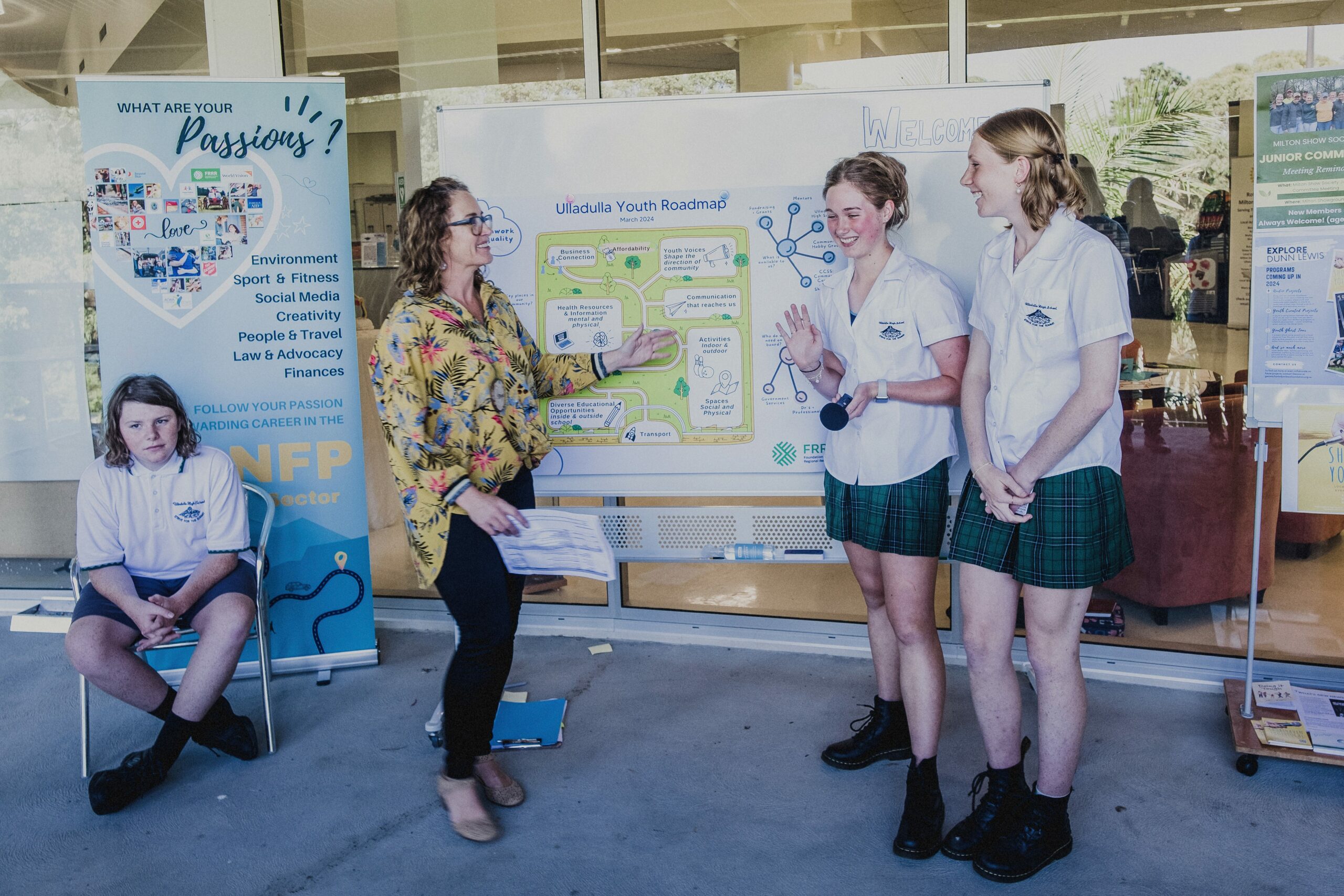
One South Coast participant reflected that, “Roadmapping was brilliant. We had a big demographic of people, and it made everything very concise and clear.”
Each roadmap developed is a unique reflection of the priorities of each IRCF community, with a few recurring themes. One of those recurring themes is engaging young people as the next generation of leadership for communities and the not-for-profit sector. This was tackled head on when young people from Ulladulla High School came together in March to develop a roadmap of their own.
The result: a ‘Youth Roadmap’ for the community with some brilliant ideas for how young people can work alongside existing community organisations, events and infrastructure to enhance them and get the next generation more involved. There is now a movement for change building in partnership with local backbone organisation, the Dunn Lewis Centre.
So why is developing a roadmap so important? They create a shared vision that can act as a map for how the community – and young people – can move forward together with greater connection and a shared vision and common goals for a thriving future.
Recently our IRCF Program Manager, Nancy Sposato, along with representatives from Junee Community Centre, Junee Community Power and Junee Shire Council spent three joyful days learning about The Art of Hosting at a workshop led by Percolab (formerly Campfire Coop) in Bright, VIC.
They came together with 40 community leaders from across the country. Each leader brought a passion for nurturing community conversations and a desire to do it better.
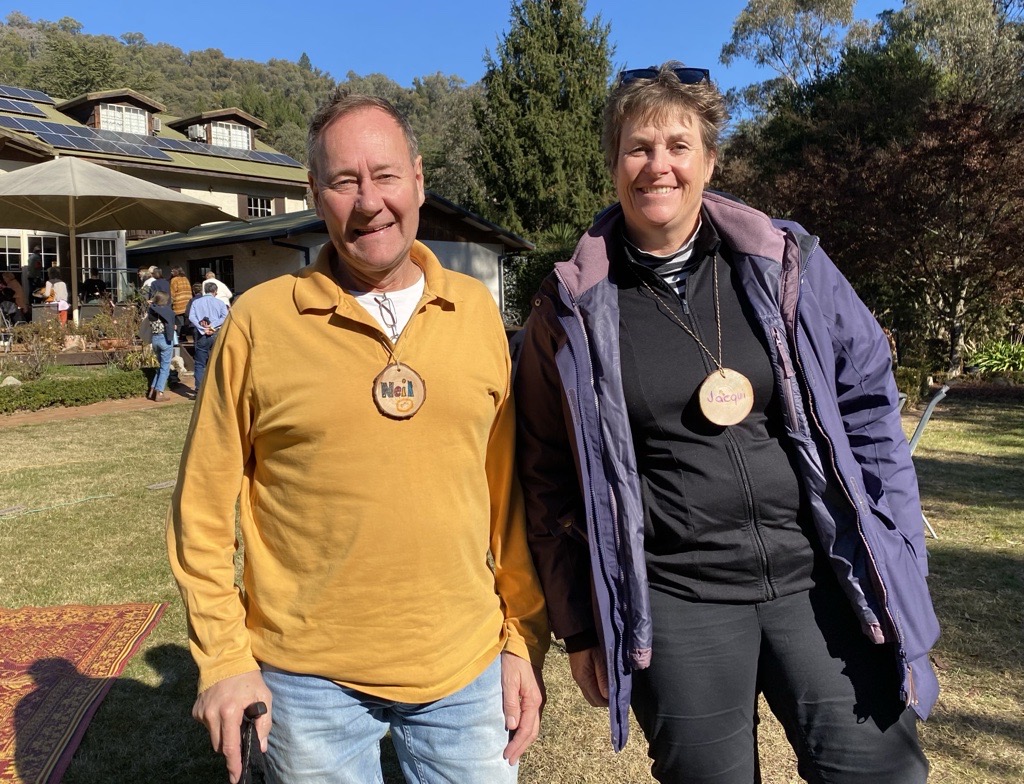
For Junee members, this participation was supported by an IRCF Toolbox grant with local leaders intending to apply skills gained towards developing effective and meaningful ways to foster inclusive community engagement and to have a shared language to be able to support each other in their efforts well into the future. The Junee initiatives that will directly benefit from this investment in people include a project that engages young people in the NFP sector, the development of culturally safe services and uptake in the renewable energy transition.
Nancy reflected, “A question that comes up time and time again is how to manage conflict and differing perspectives in a community. This is a very natural question when people are working on projects that they care strongly about and when people have invested a lot of time and energy.”
The skills gained over the three days offered efficient methods and insights into the awareness we need to have as individuals and the ways people can work together to foster positive cultures where everyone participating feels supported and included. Participants of the workshop spoke about using some of the tools they had learned immediately in work and during meetings.
Nancy and the rest of the community leaders, left with multiple techniques for having important conversations that can be applied to multiple contexts, frameworks to use for collaborative project design and creative ways to collate and share information gathered from community conversations to support greater impact and momentum.
You can check out a foundational Art of Hosting technique, the Four-Fold practice, at the link below.
Learn About The Four-Fold Practice
By Jillian Kirwan-Lee, Head of Partnerships
While it’s always good practice to thank your partners, it is usually done privately – in letters or acquittal reports, in phone calls and emails or in face-to-face meetings – and occasionally, at an event or in media releases launching a new program. And rightly so.
But we want to take this opportunity to publicly give a shout-out to the Origin Energy Foundation. While there are other organisations that we have worked with for much longer – and to whom we are equally grateful – in the case of the Origin Energy Foundation we have worked with them in multiple ways – not just in a funder / grantee relationship.
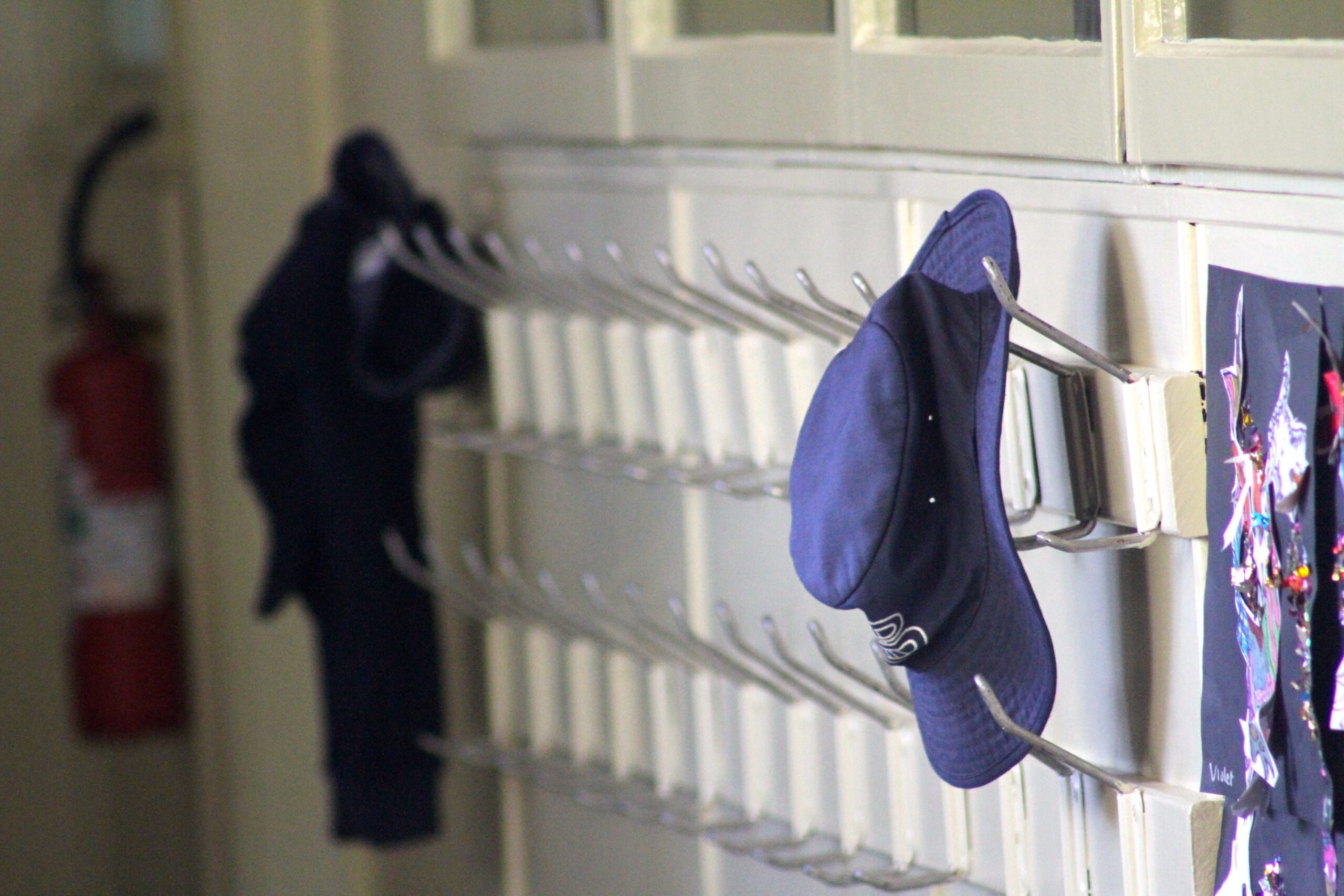
This is a great example of the value of funders and grantees building trusting relationships, which support open and transparent conversations, as called for in the Paying What It Takes report.
The Origin Energy Foundation first partnered with FRRR in 2013 on our Back to School program. This initiative, now in its final year as a stand-alone program for FRRR, saw us provide $50 vouchers through a network of community foundations and community-based delivery partners to ease the financial burden on families at the start of the school year, ensuring that children in need had the basics required to start the year with the best possible chance of being engaged in their education.
It’s a program that has had a significant impact, enhancing access to education for thousands of students and in the process, helping to build stronger, more vibrant and sustainable remote, rural and regional communities. As one recipient family put it, “My daughter is no longer embarrassed to go to school now that she has a new uniform and is no longer made fun of.” It’s hard to believe that $50 vouchers can do that – but they can, especially when additional support is wrapped around it.
We’ve experienced something similar with the Origin Energy Foundation. While they provided multi-year funding to the program for over a decade, supporting more than 20,000 families along the way, the Foundation has provided FRRR with so much more.
They advocated for us, introducing us to other organisations that could come on board as partners and writing about the importance of supporting education in remote areas in articles in mainstream media. Their staff supported the program, with matched donations through workplace giving and they shared impact stories through their employee communication channels. They helped us promote the program and its impact externally too, gifting us space in The Big Issue magazine, as well as paying for a trusted videography partner to work with us to develop two campaigns to help with additional fundraising. And when crises hit, like the Black Summer Bushfires, they contributed to an additional round of the Back to School program for students in affected communities to ensure children’s education didn’t suffer.
But perhaps most importantly, they put their trust in FRRR and provided flexible funding to direct the donations where they made the most difference, believing that we knew how best to support those that we work with.
Such collaboration and care are rare, with the philanthropic sector often directing support towards those areas that are meaningful to the funder, rather than what is needed by the community.
We take that locally-driven yet holistic approach in our own granting, as do the groups that we partner with on the ground. For example, as one of our community partners put it, “The vouchers allow us to keep an eye on the disadvantaged students and provide additional wellbeing support. Our students that receive support often do not display overt behaviours that would indicate the level of financial distress in the home. Each connection made through the vouchers allows the family to open up and share their stories, which at times has allowed us to connect them to other services in the community. Picking up the vouchers from the front office means we can connect with families that often don’t come into the school or are reluctant to meet with us.” Like the Origin Energy Foundation, we trust them to get the support where it’s most needed.
While FRRR will no longer be running the Back to School program, several Community Foundations will take it forward, customising it to meet the needs of their local community. We will have an ongoing role in building capacity of those groups, as we transition the program to local management.
Instead, FRRR will redirect our educational investment through small grants, which we know offers more flexibility to local groups to support their community in the most appropriate way.
So, while this current phase of our partnership with Origin Energy Foundation is coming to a close, we remain connected as we strive for better educational outcomes for young people living in remote, rural and regional Australia.
In the meantime, our deep thanks and appreciation to Origin Energy Foundation, for taking a flexible, generous and trusting approach for all you do for young Australians in need.
Four Victorian philanthropic organisations have joined forces in an exciting $5 million partnership with the Foundation for Rural & Regional Renewal (FRRR) that will strengthen the capacity and resilience of communities over the next five years.

Three Victorian communities will be named later this year, following a detailed process involving needs analysis, mapping key issues, causes of disruption and the funding landscape, and an exploration of community readiness for the investment.
The partnership comprises the Helen Macpherson Smith Trust, the Jack Brockhoff Foundation, The Ross Trust, and William Buckland Foundation. FRRR will deliver the program, following the success of its similar Investing in Rural Communities Futures program (IRCF) in NSW over the past five years.
The funding will enable local not-for-profits (NFPs) to become more confident and collaborative in their approach to improving and sustaining the vibrancy, resilience, and liveability of their communities, ultimately enabling them to thrive, not just survive, especially during times of natural disasters.
“Investing in and strengthening the social and economic fabric of Victorian rural communities fosters long-term resilience,” says the CEO of FRRR, Natalie Egleton. “We know that our model can deliver these outcomes, and the multi-year model builds a whole-of-community approach.”
The $5 million funding will be used to employ local facilitators, deliver capacity building activities for the local NFPs such as governance training, volunteer development, marketing and fundraising support, and events. Funds will also be allocated to the three communities via grants for priorities and for organisational capacity building. Evaluation is central to the program.
The NSW program
The NSW program started in 2018 after FRRR recognised that many grassroots organisations were ‘locked out’ of philanthropy and often unable to access opportunities to invest in their own organisational capacity due to their size, distance, financial capacity, and lack of staffing.
“Most of the NFP work that happens in small towns is volunteer run and there just isn’t any money or resources to help them be sustainable,” Natalie said. “Local leaders know what is going to make the biggest difference in their community and we knew that supporting local solutions would be key.”
The program commenced in Junee, Leeton, and Nambucca Valley with the support of Vincent Fairfax Family Foundation. The Snow Foundation and Bendigo Bank then joined to enable FRRR to take the program to Ulladulla, Batemans Bay, Nowra, and Bay & Basin. The Australian Government provided additional funding to expand the program in the Shoalhaven region and launch the program in Bega through their Black Summer Bushfire Recovery Program.
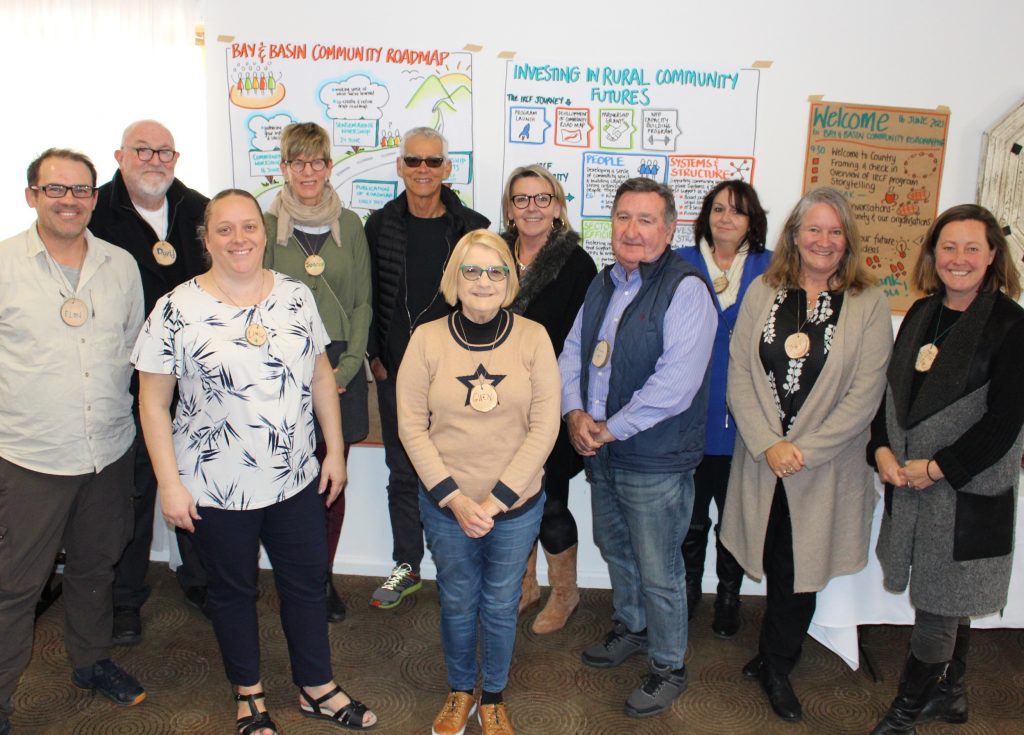
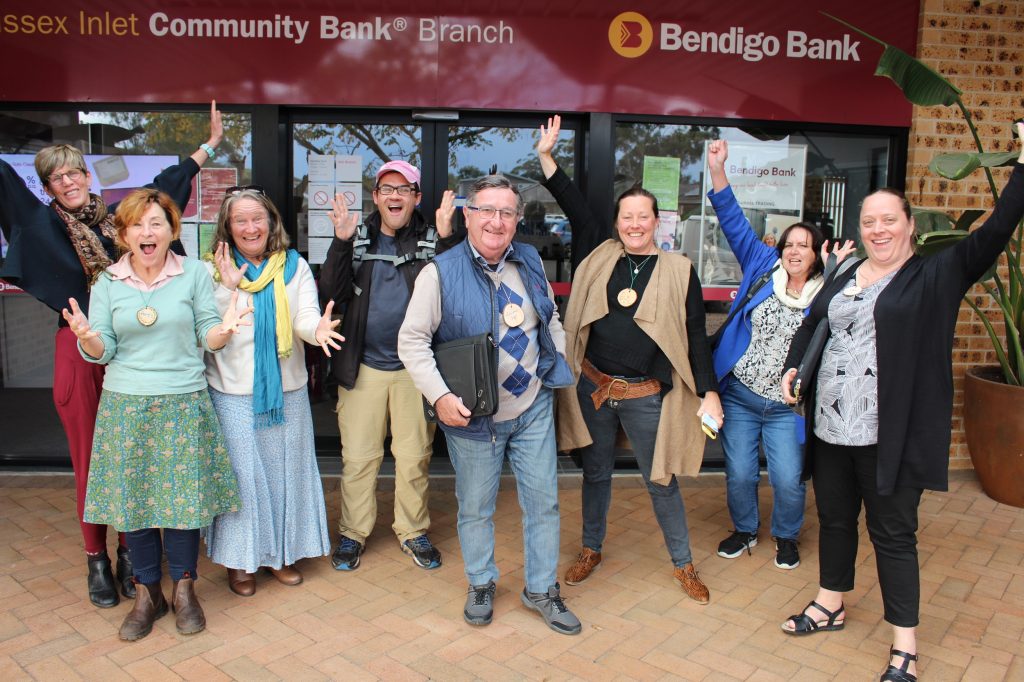

Evolution of the Victorian partnership
The plan to bring a similar program to Victoria began in late 2022 after The Ross Trust began discussions with FRRR and the Helen Macpherson Smith Trust. Conversations then began with the Jack Brockhoff Foundation and William Buckland Foundation. Importantly, the leaders in all these organisations had strong existing relationships and numerous granting collaborations with each other, as well as with FRRR.
“I could see that this program was about building the skills, resources and capacity of local not-for-profits – and that it was working,” said Sarah Hardy, the CEO of The Ross Trust. “It was also clear that any Victorian partnership would need a commitment of $5 million to get off the ground. That is a lot of money for any one mid-sized philanthropic, when we all have ongoing projects.”
Sarah said the positive and trusting relationships between the five organisations meant they were able to openly discuss whether it was a project that their trustees and directors would support.
The CEO at the Helen Macpherson Smith Trust, Debra Morgan, said the early conversations and resulting partnership benefited from like-minded organisations working together.
“We realised early that we couldn’t do anything this significant alone, and that working together would help us to affect better and longer-term change,” Debra said. “This collaboration sets a new bar in how we work together, and it’s certainly the longest-term project we have funded under our new strategy.”
Louise Kuramoto, the CEO of the Jack Brockhoff Foundation, said that it was the first time, other than a commemorative grant, the foundation had made a five-year commitment to a project.
“The philosophy behind this program is not unusual, but the amount and duration are,” Louise said. “The solid track record of FRRR gave all four funders the confidence to invest at such a scale. It’s wonderful that we can come together to support communities and the people in them.”
For the Grants Lead of William Buckland Foundation, Ferdi Hepworth, the program perfectly aligns with her organisation’s long commitment to country Victorians.
“We have had a long partnership with FRRR and more recently we’ve been funding a program where FRRR distributes small grants to communities, and we had already been talking about how we could better support them,” Ferdi said. “It was very easy to say yes to being part of this partnership.
“We often see governments and big business leading change, but it’s the people in the community who best know the ingredients required to help that community thrive. This project supports those people with the skills, knowledge, and confidence to work together to achieve change.”
After many emails, online and in-person meetings, visits to NSW communities, and discussions with their trustees and directors, the four funders set themselves a deadline of June this year to see if they could raise the $5 million to commence the program in July 2025. By April, they had done it.
“For four mid-sized philanthropic organisations to raise $5 million when we already have current commitments shocked us all, but in a good way,” Sarah said.
How the program will work in Victoria
FRRR will study past granting trends and community profiles and will map issues and disruptions occurring or on the horizon, as well as the funding landscape, to select the three communities. The process will also include community consultation, with a shortlisting process that will invite expressions of interest. Given the program is grounded in deep collaboration and co-design with each community, it is vital that there is a sense of readiness to embark on the five-year partnership.
Once communities are selected, a locally based community facilitator will work with the local NFP sector to scope priorities, gaps and opportunities that will be collated into a sector roadmap. The roadmap, which will be refreshed annually, will be the framework for activating capacity building activities and funding, and for monitoring progress, celebrating change, and adjusting priorities as needed.
Natalie from FRRR said she was confident many Victorian communities would be enthusiastic about the opportunity, adding that, like in NSW, it was likely the communities would be at very different starting points.
“Success is turning out to be different in each community, which is fine because the indicators we are interested in all focus on changes in mindset and sector collaboration to drive new and better opportunities for their communities – and that has been a major success,” Natalie said.
FRRR will employ a program manager who lives in Victoria and is familiar with key concerns and issues in the state. Local facilitators will also be employed in each community. Over time, it is expected that more than 20 people will be employed in the program. Staff and volunteers will benefit from training and professional development and possibly partnerships with councils, TAFEs and universities.
Deb Samuels is the People Portfolio Lead at FRRR and will oversee the Victorian project.
“We now have five years of NSW evaluation data and interviews and the recurring theme is that people in the communities feel much more empowered to make decisions and collaborate,” Deb said. “If they know a large grant opportunity is coming up, they know who to call to say, ‘let’s pool our efforts to apply’.”
Deb cited examples of success that could be replicated in Victoria, such as one NFP leader rallying to halt the closure of a local bank branch that was relied upon by vulnerable residents, and another leader now running for mayor.
“Local leaders involved in the IRCF program have shared they would not have had the confidence to do things like that in the past,” Deb said. Young people can also engage with the program and see themselves as an important part of the NFP sector.
“One of the best things somebody said to me is that ‘the funders believed in us and invested in us, and now we believe in ourselves and what we can do’.”
By Jill Karena, Place Portfolio Lead
Philanthropy invests significantly in communities by making grants right across Australia. In FRRR’s case, we are focused on supporting remote, rural and regional communities, especially grassroots organisations that often can’t access traditional philanthropy. However, there is no one-size-fits-all solution, which is why we offer a range of programs – some where we work deeply over multiple years through place-based initiatives to build the capacity of a group of local not for profits, and others where we work broadly through our small grants programs – offering up to $25,000, although most are around $10,000.
These small grants programs are our most in-demand which are well suited to co-funding approaches that enable collective contributions to achieve more together and create leverage for funders and communities. While not always ‘sexy’, the needs met through these grants address areas of disadvantage and basic quality of life in communities with little visibility to funders and policymakers. They range from upgrading toilets and kitchens, which improves accessibility of community facilities, to installing air-conditioners to manage climate extremes, and seed funding new ideas to stimulate new approaches to volunteering, health services, and disaster preparedness. Moreover, their value goes far beyond the dollars themselves. From more than 20 years of experience, we can safely say that in the case of many grassroots community groups, small is good.
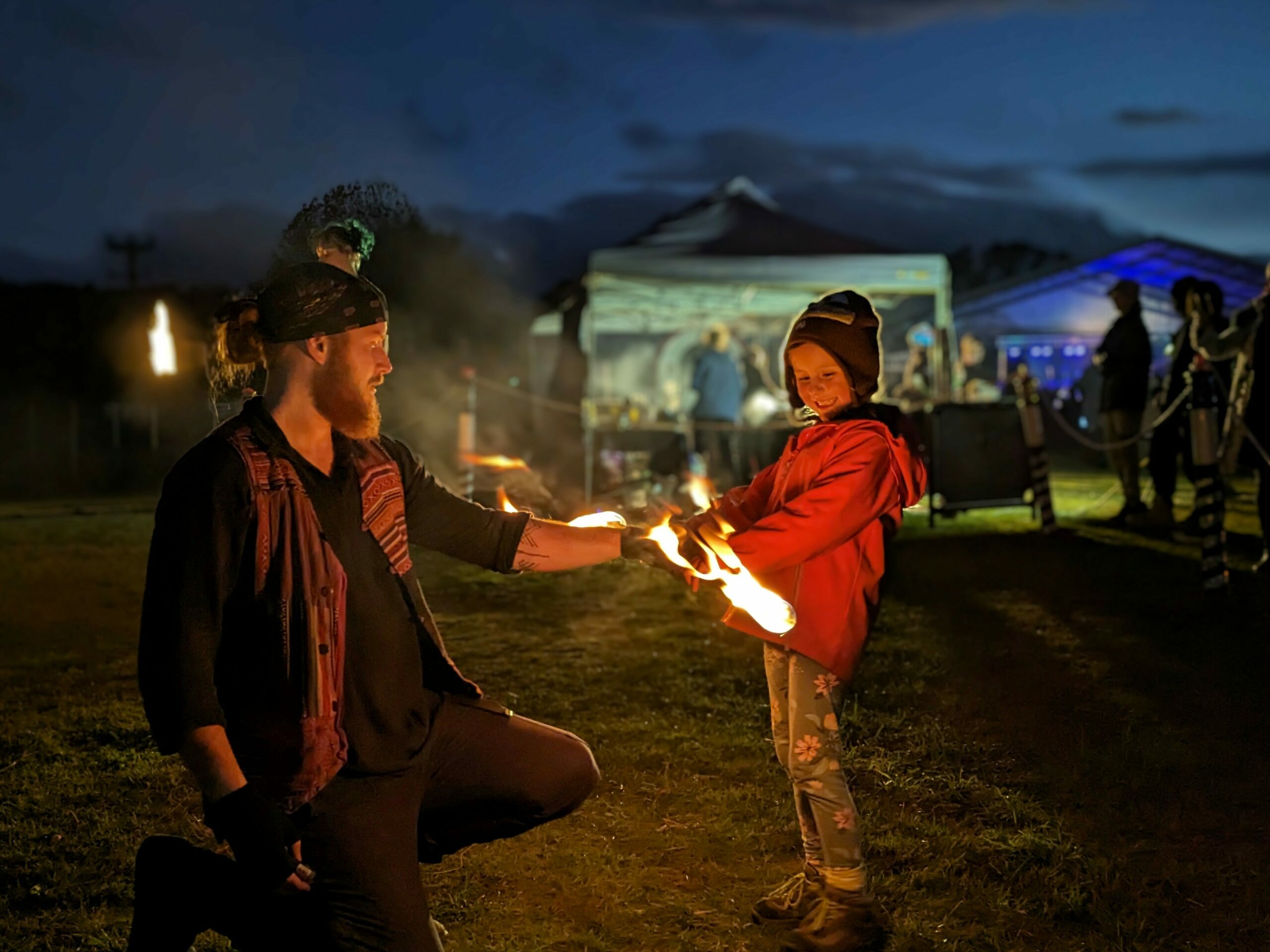
Small grants, big impact
By their very nature, small grants are simpler to navigate and have lower barriers to entry, making them more appealing to a wider range of organisations. Some grant programs, like FRRR’s Strengthening Rural Communities, also offer expert support by phone or email, making the process even easier.
Small grants can be the straightforward and friendly ‘front door’ through which grassroots organisations can step to build their capability, connect their community and navigate and drive change. In fact, for many communities experiencing disadvantage, small grants are one of the few ways that they can get the resources and opportunities to launch new ideas or approaches in their communities. And they deliver far more than just money.
Dipping a toe in, learning as they go
For communities that have not applied for funding before, small grants build their experience and confidence in developing project ideas, applying for funding, project management, budgeting and meeting reporting requirements. In the last 12 months, more than a third of Strengthening Rural Communities grant applicants (503 organisations) were first time applicants. Even if they aren’t successful the first time around, constructive feedback, such as the detailed information we always offer to unsuccessful applicants, can give them the confidence to apply again.
Biting off just what they can chew
Many communities are great at developing a long-term vision for their community that might focus on local services, economic development, environmental sustainability or climate change adaption but much as they’d like to do so, it’s simply not possible to achieve everything at once. Small grants enable a community to tackle making those big changes one project at a time. This supports them to make incremental progress against their long-term goals, while the lower scrutiny and risk associated with a small amount of funding can be less anxiety-inducing for organisations who are new to grant seeking.
Attracting more funding
Securing their first small grant is a pivotal moment for an organisation. It’s not just about funding support – it is also a recognition of the value of an organisation’s work and its ability to contribute to their community’s future. Once they’ve been successful, it’s often a catalyst for aiming higher and developing self-belief and self-reliance to create positive change in their community.
Demonstrating that they can successfully manage their first small grant and deliver tangible results builds an organisation’s credibility and can help open the door to securing larger grants to scale-up their project or take on a more ambitious idea. Often, it’s also the vote of confidence that other donors need to see to also come in and support the group’s work.
Getting to work sooner
Small grants usually have shorter application and approval timelines and offer more flexibility to enable communities to tailor projects to meet local priorities and needs, or quickly respond to unexpected disasters and other shocks. Smaller grants also usually come with fewer restrictions and reporting requirements compared to larger grants, which can often make it easier to negotiate with the funder to adapt their project if conditions change.
Finding and piloting local solutions
The flexibility of small grants also encourages communities to experiment with local problem solving, potentially sparking new approaches that are scalable or portable to other communities. Often small grants are seed funding to pilot locally generated or adopted ideas that are not of interest to larger grant programs. Using small grant funding to demonstrate the viability of a community idea can generate the evidence needed to secure larger grants or other support to bring the idea to reality.
“Thank you so much for providing the funds for this grant. This renovation has given Council initiative to support the Toy Library by maintaining the building so we can provide an inviting space and nurturing space for the community. The Toy Library has had many, many years of dedication by passionate volunteers to support and nurture the children of Tamworth and I think it deserves it!
When I started as president the library looked awful and didn’t reflect the commitment, love and pride that our small but dedicated group deserved. Now I feel like our space reflects our organisation. An important community organisation that cares and values the children, parents and carers of Tamworth and feels that learning through play is core to a child’s life and development! Another positive change is that the renovations have been a catalyst for council to complete much needed (and much requested) maintenance on the building by fixing gutters, replacing doors and cracked tiles and replacing the old sink and toilet.”
Tamworth Toy Library Incorporated
Connecting the Community

Small grants also offer a reason for different groups in the community to work together to develop and deliver projects that are meaningful and manageable. When community members, other community organisations and Local Government see the results from a small grant project that makes their community better, it is a great morale booster, and they are more likely to be motivated to get involved in future community initiatives.
“The event’s success lies in its ability to bring the community together, boost the local economy, and celebrate cultural heritage. The event provided a platform for residents to come together after the floods, share their experiences, and rebuild social connections. Through artistic workshops, events, and exhibitions, community members bonded over shared creative experiences, fostering unity and a sense of belonging.”
Arts Deloraine – festival / youth workshops (flood recovery)
Building local capacity
It’s not just the mere fact of offering smaller-value grants that makes an impact. It’s what those grants fund that also helps to build local capacity, especially in small communities or where a new group has formed. For example, many of the grants FRRR funds are about helping groups build their own capacity – whether that’s the likes of governance training or strategic planning support.
“The grant received for strategic planning has paid for itself many times over. We had members who had ideas in their head but didn’t know how to plan or implement them. Since receiving the grant, we’ve been able to increase attendance of our market to over 5000 visitors in November 2021! We’ve also been able to provide free stalls to local community groups to increase their outreach. This also has a flow on effect to small businesses in the town. The pub is booked out for lunch, little local businesses thrive due to the amazing success of the market.”
Rotary Club of Kinglake Ranges
Bigger is not always better

Often, we hear suggestions that larger grants are better – but the reality is that many of the most deserving groups in the smallest and most remote locations simply will not – or indeed simply are not able to – apply for many of those grant opportunities.
While it’s great to see larger grants made available to communities, especially through Government programs, it is critical that we not lose sight of how important small grants are in strengthening capability and capacity in remote, rural and regional communities. Small communities, as you might guess, are, well… small! This can make it hard to compete with larger communities, especially when it comes to demonstrating measures of impact which funders often ask for – small communities can’t point to economies of scale or large numbers of beneficiaries.
With fewer people to draw on, volunteers are often stretched and there are less likely to be paid resources or an experienced grant writer to chase high-value grants or manage large-scale projects. Groups often won’t apply because they don’t have the capacity to meet the reporting requirements or to manage the other governance expectations, such as the frequency of reporting or detailed probity plans. Even the prospect of managing large sums of money can be scary for a first-time grant applicant and some small communities can find it simply overwhelming!
What makes small grants so impactful in rural and remote Australia is their flexibility and relative simplicity, which means they’re more accessible and attractive to those communities that don’t have the resources to wrestle with the complexities of large grants. So we urge all those who are working so hard to grow the funds that are directed via the social sector to make sure that small grants continue to be a key stream of funding. If you’re funding large grants, consider coupling that with some smaller grant funding as well – they may well become organisations you’re able to fund in the future. Or, if you’re funding with a very tight focus, consider how small grants with more flexibility may bring unexpected pathways to that impact. Of course, we always welcome more partners for our collaboratively-funded Strengthening Rural Communities program, so get in touch if you’d like to know more.
In November, around 25 supporters joined the FRRR directors, CEO and Partnerships Team for a donor event held at the Nutrien Ag Solutions offices in Docklands, Melbourne. Dialling into the event as a guest speaker was Jacqui Bramwell from Alpine Valleys Community Leadership (AVCL) program.
Based in the Alpine Valley in north east Victoria, AVCL is dedicated to supporting their region by building strong leadership among locals, to create thriving, connected and resilient communities.
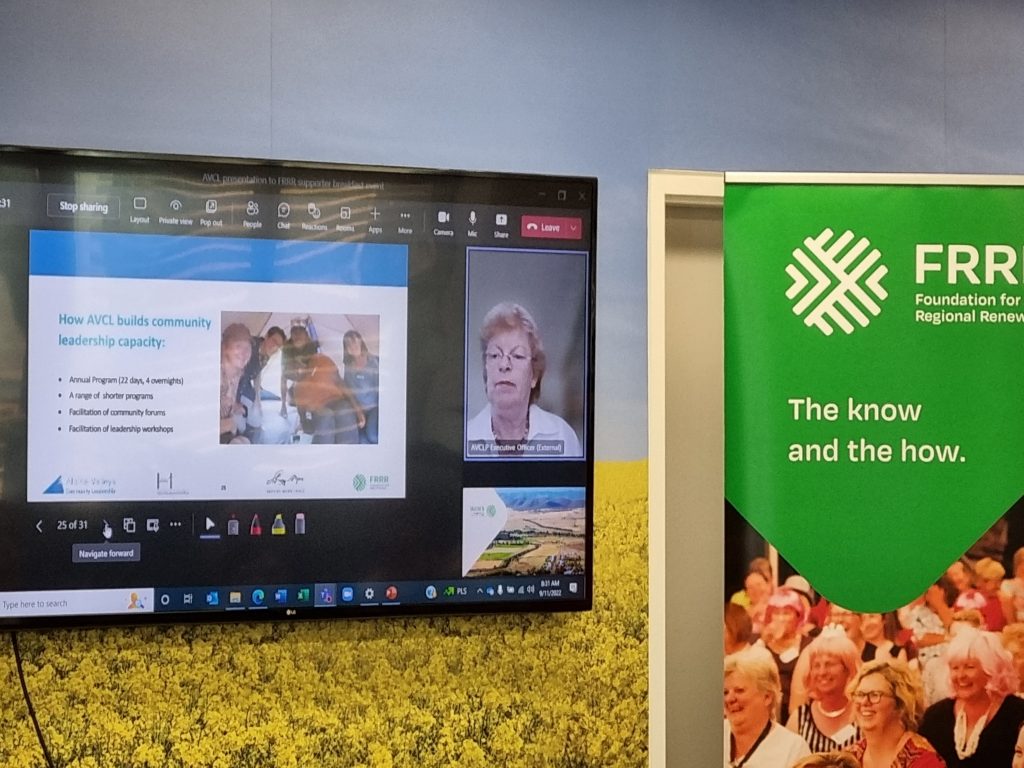
Back in 2019/20, the Alpine Valley was heavily affected by the Black Summer bushfires. The fires destroyed homes, livestock, 3,387km of fencing, and in the Alpine Shire 30% of the shire footprint had some of the worst air quality in the world, causing smoke taint on the grapes in the many local wineries.
For these communities in the north east, recovery took many forms. Immediate recovery needs included finding food and shelter for displaced people and repairing fences to keep livestock contained. But as time passed, recovery needs changed and the focus turned to the future.
In 2021, AVCL received a $90,000 multi-year grant from FRRR, through the Bushfire Recovery Fund, funded by the Helen Macpherson Smith Trust (HMSTrust) and the Sidney Myer Fund. The grant was to build their capacity to strategically plan and deliver leadership training that will effectively support and build community recovery in the area.
This FRRR grant program supports not-for-profit community groups who play a central coordinating or networking role in supporting communities to recover from the Black Summer bushfires and to build organisational capacity.
Jacqui joined the meeting to share progress to date in implementing their grant and to provide some insights into the ongoing recovery.
A key goal for AVCL was to develop a recovery component in their organisation’s strategic plan, including developing specific workshop programs and resources and to make them more accessible to community members.
To understand what the broader community needed, they started by consulting widely. They connected with their 500 alumni across the north east region. They also contacted local authority Recovery Managers and Neighbourhood Centres who are well connected within their communities to hear first-hand what locals need.
“The key themes from those consultations were the challenges around supporting and sustaining community-led recovery. For the community to lead the recovery process, they need to have the leadership and project management skills,” Jacqui explained.
She noted that the scale of the recovery has affected all other activities in the Shires, taking community leaders away from other organisations they are normally active in.
“In this region, there are up to 10 Community Recovery Committees due to the vast impacts of the fires and the geography. That means a lot of people. This highlights the importance of building the next generation of leaders to backfill those positions on the committees of organisations such as CWA, the SES, the local cemetery management committee etc. Improving the leadership skills of more people can help to expand the reach of recovery efforts and strengthen the future of community more broadly.
Another aspect that Jacqui highlighted was the need to be proactive and consider future sustainability of the region. Some communities have told AVCL that they want to take a bigger view, in the face of rapid climate change and the intensity and frequency of these events. They are interested in transformational change, such as considering changing a community’s economic base.
To support local leaders through this, they have arranged trips to other communities that have had to transform, such as Derby in Tasmania, which has evolved from a mining community into an adventure-based tourism community, attracting thousands of people. These trips are an important opportunity to explore how to take it from being a concept to being a reality. Hearing directly from the people that have driven that in a community where it’s worked is important for them. They can take those lessons on board as to how to drive that sort of change in their own communities.
Over the next two years, the remaining funds will go towards actually delivering these resources and learnings to local communities.
“AVCL will coordinate leadership development in governance, project management and other specific leadership skills requested, ideally attracting other funding so the training can remain free or at only nominal cost.”
We look forward to sharing what else they learn as this project continues to roll out.

